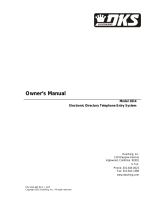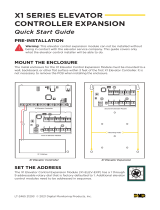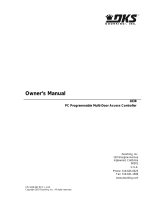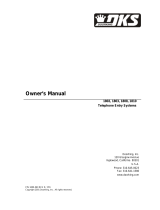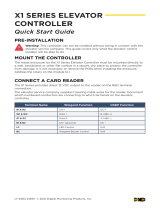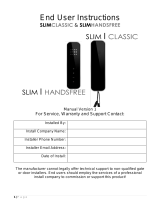Page is loading ...

1818
PC Programmable Multi-Door Access Controller
Owner’s Manual
DoorKing, Inc.
120 Glasgow Avenue
Inglewood, California
90301
U.S.A.
Phone: 310-645-0023
Fax: 310-641-1586
www.doorkin
g
.com
P/N 1818-065 REV H, 4/02
Copyright 2001 DoorKing, Inc. All rights reserved.

2

3
Use this manual with the following models only.
All 1818 Series with circuit board 1842-010 Rev D or higher.
DoorKing, Inc. reserves the right to make changes in the products described in this manual
without notice and without obligation of DoorKing, Inc. to notify any persons of any such revisions
or changes. Additionally, DoorKing, Inc. makes no representations or warranties with respect to
this manual. This manual is copyrighted, all rights reserved. No portion of this manual may be
copied, reproduced, translated, or reduced to any electronic medium without prior written consent
from DoorKing, Inc.

4
Preface
Important Notices .................................................................................................................................................6
Important Information............................................................................................................................................7
Features .............................................................................................................................................................8
Section 1 – Installation
1.1 Installation Guidelines...........................................................................................................................9
1.1.1 Mounting Information ............................................................................................................10
1.2 Memory Chip Installation.......................................................................................................................11
1.3 Circuit Board Terminal Identification .....................................................................................................12
1.3.1 Main Terminal Description.....................................................................................................13
1.3.2 Data (Weigand) Terminal Description ...................................................................................14
1.3.3 Weigand Power Terminals ....................................................................................................14
1.3.4 Elevator Control Terminals....................................................................................................15
1.3.5 RS-232 Terminals .................................................................................................................15
1.4 Circuit Board Adjustments ....................................................................................................................16
Section 2 – Wiring
General Information ..............................................................................................................................................17
2.1 Block Diagram – 1 or 2 Door System ....................................................................................................18
2.2 Detail Wiring – 1 or 2 Door System.......................................................................................................19
2.3 Postal Lock Box Installation and Wiring ................................................................................................20
Section 3 – Programming
3.1 General Programming Information
3.1.1 Programming with a PC ........................................................................................................21
3.1.2 Programming from the Keypad .............................................................................................21
3.1.3 System Memory....................................................................................................................22
3.2 Programming with a PC
3.2.1 Master Code .........................................................................................................................23
3.2.2 Single or Multiple Systems ....................................................................................................23
3.2.3 PC Programming Table.........................................................................................................24
3.3 General Programming
3.3.1 Relay Strike Time..................................................................................................................25
3.3.2 Tone Open Numbers.............................................................................................................25
3.3.3 Postal Switch ........................................................................................................................26
3.3.4 Programming the Directory Code Length ..............................................................................26
3.4 Device Codes
3.4.1 Programming Device Codes .................................................................................................27
3.4.2 Deleting Device Codes..........................................................................................................27
3.5 Four-digit Entry Codes
3.5.1 Programming Four-digit Entry Codes ....................................................................................28
3.5.2 Delete Four-digit Entry Codes ...............................................................................................28
3.5.3 Entry Code Ranges...............................................................................................................28
TABLE OF CONTENTS

5
Section 4 – Operating Instructions
4.1 User Instructions
4.1.1 Card Access......................................................................................................................... 29
4.1.2 RF Transmitters ................................................................................................................... 29
4.1.3 Five-Digit PIN Codes............................................................................................................ 29
4.1.4 Four-Digit Entry Codes......................................................................................................... 29
4.2 System Administrator
4.2.1 Opening from a Remote Location......................................................................................... 30
4.2.2 Tracker Board Override Hold Open Command..................................................................... 30
4.2.3 Relay Check......................................................................................................................... 30
Section 5 – Maintenance and Trouble Shooting
5.1 Trouble Shooting
............................................................................................................................... 31
5.1.1 RS-232 Test......................................................................................................................... 33
5.1.2 Floor, Elevator, Security Level Test Programming................................................................ 34
5.1.3 Elevator Board Hardware Test ............................................................................................. 34
5.1.4 Elevator Board Floor Hardware Test .................................................................................... 35
5.2 Accessories
........................................................................................................................................ 36
Log Tables ........................................................................................................................................... 37

6
FCC - UNITED STATES
This equipment has been tested and found to comply with the limits for a class A digital device,
pursuant to Part 15 of the FCC Rules and Regulations. These limits are designed to provide
reasonable protection against harmful interference when the equipment is operated in a commercial
environment. This equipment generates, uses, and can radiate radio frequency energy and, if not
installed and used in accordance with the instruction manual, may cause harmful interference to radio
communications. Operation of this equipment in a residential area is likely to cause harmful
interference in which case the user will be required to correct the interference at his own expense.
FCC Registration Number: DUF6VT-12874-OT-T
DOC - CANADA
The Canadian Department of Communications label identifies certified equipment. This certification
means that the equipment meets certain telecommunications network protective, operational, and
safety requirements. The Department does not guarantee the equipment will operate to the users
satisfaction.
Before installing this equipment, users should ensure that it is permissible to be connected to the
facilities of the local telecommunications company. The equipment must also be installed using an
acceptable means of connection. The customer should be aware that compliance with the above
conditions may not prevent degradation of service in some situations.
Repairs to certified equipment should be made by an authorized Canadian maintenance facility
designated by the supplier. Any repairs or alterations made by the user to this equipment, or
equipment malfunctions, may give the telecommunications company cause to request the user to
disconnect the equipment.
Users should ensure, for their own protection, that the electrical ground connections of the power
utility, telephone lines, and internal metallic water pipe system, if present, are connected together.
This precaution may be particularly important in rural areas.
CAUTION: Users should not attempt to make such connections themselves, but should contact the
appropriate electric inspection authority, or electrician, as appropriate.
DOC Registration Number: 1736 4528 A
Notice:
The Load Number (LN) assigned to each terminal device denotes the percentage of the total load to
be connected to a telephone loop which is used by the device, to prevent overloading. The
termination on a loop may consist of any combination of devices subject only to the requirement that
the sum of the load numbers of all the devices does not exceed 100.
Notice:
DoorKing does not provide a power transformer on units sold into Canada. Use only transformers that
are CSA listed to power the telephone entry system. 1802, 1803, 1808, 1810, 1814, 1815, 1818 and
all "P" series systems require a 16.5-volt, 20 VA transformer. The models 1816 and 1817 require a
16.5-volt, 40 VA transformer. The model 1812 requires a 24-volt, 20 VA transformer.
Listing:
This product has been tested to and found to be in compliance with the U.L 294 Safety Standard by
Intertek Testing Services NA Inc. (a Nationally Recognized Testing Laboratory) and is ETL listed.
IMPORTANT NOTICE

7
• Prior to beginning the installation of the access control system, we suggest that you become
familiar with the instructions, illustrations, and wiring guidelines in this manual. This will help
insure that you installation is performed in an efficient and professional manner.
• The proper installation of the access controller is an extremely important and integral part of
the overall access control system. Check all local building ordinances and building codes
prior to installing this system. Be sure your installation is in compliance with local codes.
• When used to control a door or pedestrian gate, try to locate the access controller as near as
possible to the entry point. The unit should be mounted on a rigid wall to prevent excessive
shock and vibration from closing doors or gates. Continuous vibration and shock from
slamming doors or spring-loaded pedestrian gates will damage the circuit board. Under no
circumstances should the unit be mounted directly to a moving door or gate.
• ADA mounting requirements for door control. The mounting of the access control device
(card reader, keypad, etc.) shall be in such a way that it is readily usable by a person sitting
in a wheelchair with an approximate eye level of 45 inches and shall comply with the
following requirements:
1. If the clear floor space allows only forward approach to the device, the maximum high
forward reach allowed is 48 inches above grade to the top of a keypad.
2. If the high forward reach to the system is over an obstruction of greater than 20
inches but less than 25 inches, the maximum high forward reach allowed is 44 inches
above grade to the top of a keypad.
3. If the clear floor space allows parallel approach by a person in a wheelchair, the
maximum high side reach shall be 54 inches above grade to the top of a keypad.
4. If the high side reach is over an obstruction of 24 inches or less, the maximum high
side reach allowed is 46 inches above grade to the top of a keypad.
• When used to control a vehicular gate with an automatic gate operator, the access
control device (card reader, keypad, etc.) must be mounted a minimum of ten (10) feet
away from the gate and gate operator, or in such a way that a person cannot operate
the device and/or touch the gate or gate operator at the same time.
• Be sure that access control devices are installed so that they are not directly in the traffic
lane. Gooseneck mounting post and kiosks work well for these type systems. When
planning where to locate the access device, take into consideration traffic lane layouts, turn
around lanes for rejected access, conduit runs, power availability, etc.
• This access system controller contains a number of static sensitive components that can be
damaged or destroyed by static discharges during installation or use. Discharge any static
prior to removing the circuit board by touching a proper ground device.
• Instruct the end user to read and follow these instructions. Instruct the end user to
never let children play with or operate any access control device. This Owner’s
Manual is the property of the end user and must be left with them when installation is
complete.
IMPORTANT INFORMATION

8
• Can provide service for up to 3000 system users and can store up to 8000 card, transmitter
or digital PIN codes when ordered with 3000 MemPLUS chip set.
• System can be programmed via modem or RS-232 interface with the Remote Account
Manager for Windows software included with the unit. Programming via RS-232 requires an
additional cable that is not included with the unit (P/N 1818-040).
• Transaction buffer stores the last 8000 events and has its own backup power source to retain
memory during power outages.
• 31-security levels total (security level 00 always denies entry, security level 01 always admits
entry), with 29 programmable security levels, each with four time zones allows you to control
and restrict user access as needed.
• Two internal relays allow the system to control two entry points.
• System can be expanded to control up to 16 entry points. Tracker expansion boards are
required (one for each additional entry point) and are not included with the system. Tracker
boards also provide output for door ajar and forced entry alarms.
• Optional elevator control board(s) can control up to four elevators with each elevator serving
up to 64 floors.
• System will interface with selected models of DKS DoorKing vehicular gate operators to
provide gate operator information and data (requires a Tracker board for each gate operator
that is to send data to the system).
FEATURES

9
SECTION 1 - INSTALLATION
If you are going to use a telephone line with this controller, order it at least two weeks prior to the
planned installation date. This will assure that a phone line is available when the unit is installed.
The telephone company will require the following information from you:
Type: Touch Tone, Loop Start
Ringer Equivalence: 0.0 A
Jack Type: RJ11C
FCC Registration (US): DUF6VT-12874-OT-T
DOC (Canada): 1736 4528 A
Electrical Listing: Complies with U.L. 294 - ETL Listed
.
1. Open the cabinet of the access controller and disconnect the keypad ribbon cable from
the main circuit board.
2. Remove the 6-32 x 1/2 round head screws from the right side of the circuit board.
3. Remove the circuit board by gently pulling it out of the main terminal edge connector.
CAUTION - the circuit board contains static sensitive components. Discharge any static
electricity from your hands by touching a proper ground device before removing the
circuit board. Place the circuit board where it will not be damaged.
4. Mount the access controller cabinet using 8-32 screws. The access controller has four 8-
32 blind pems installed in each corner. See page 10.
5. Route wiring into the cabinet. Do not apply any power at this time.
6. Clean out the cabinet. Be sure that all dirt, metal and/or wood debris is removed from the
cabinet and that the terminal strip edge connector is clean and free of any loose particles.
7. Re-install the circuit board into the cabinet by gently pushing the circuit board terminals
into the edge connector. CAUTION - the circuit board contains static sensitive
components. Discharge any static electricity from your hands by touching a proper
ground device before removing the circuit board.
8. Secure the circuit board to the cabinet using the screws removed in step 2.
9. Plug the keypad ribbon cable into the circuit board. The cable points to the left.
WARNING! If this access control system is used to control a vehicular gate
with an automatic gate operator, the access control device must be mounted
a minimum of ten (10) feet away from the gate and gate operator, or in such a
way that a person cannot operate the access control device and touch the
gate or gate operator at the same time.
1.1 Installation Guidelines

10
1.1.1 Mount Information
If used to control a door or pedestrian gate, try to locate the access controller as near as possible to
the entry point. The unit should be mounted on a rigid wall to prevent excessive shock and vibration
from closing doors or gates. Continuous vibration and shock from slamming doors or spring-loaded
pedestrian gates will damage the circuit board. Under no circumstances should the unit be
mounted directly to a moving door or gate.
text
10.75
12.25
9.0
10.0
.5
.625
10.25
4.0
3.75
6.0
12.0
2.0
1.5
.875 KO
3-Places
1.25 KO
2-Places
Model 1818 Controller Mounting Dimensions
DOORKING, INC., INGLEWOOD, CA 90301
Title:
Date: Rev.Dwg. No.
A
4/02 M1818-065-1

11
The access controller is shipped with two memory chips packaged in a separate box inside the
shipping container. The memory chips must be installed for the system to operate.
CAUTION!! Do not install the memory chips with power to the system turned on. Attempting
to install the memory chips with power on will irrevocably damage the chips.
CAUTION!! The memory chips are a static sensitive component. Discharge any static
electricity from your hands by touching a proper ground device before removing the control
board. Handle the memory chips with care.
1. The large memory chip
socket is colored black
and is located in the
center of the circuit board.
Be sure that the handle is
in the un-locked position
(pointing up). Be sure
that power to the
telephone entry system is
off.
2. Carefully insert the
memory chip into the
socket. The small half
circular indentation on the
chip must be to the right.
CAUTION: Installing the
memory chip backwards
will cause permanent
damage to the chip. Be
sure that the memory chip
is seated correctly in the
socket.
3. Move the lever on the
chip socket to the locked
position (down).
4. Install the small memory
chip in the socket located
at the bottom of the circuit
board. The small circular
indentation on the chip
must be to the right. CAUTION: Installing the memory chip backwards will cause
permanent damage to the chip. Be sure that the memory chip is seated correctly in the
socket. If it is necessary to remove this chip, use a small bladed flat blade screwdriver to
carefully pry the chip from the socket. Take extra caution to be sure to not bend the pins
on the chip.
1.2 Memory Chip Installation
RS 232
6
1
Relay 0
NO
NC
C
Weigand
Input
1
10
Elevator
Control
Weigand
Power
1
3
1
20
19
18
17
16
15
14
13
12
11
10
9
8
7
6
5
4
3
2

12
1.3 Circuit Board Terminal Identification
SEC LEVEL
VOLUME
MASTER
CODE
RING PIN
RLY 2
RS 232
61
Weigand
Input
110
Elevator
Control
Weigand
Power
13
1
20
19
18
17
16
15
14
13
12
11
10
9
8
7
6
5
4
3
2
DOORKING, INC., INGLEWOOD, CA 90301
Title:
Date: Rev.Dwg. No.4/02 M1818-065-2
A
1842-010 Board Settings and Terminal Locations
1842-010 Control Board Settings and Terminal
Locations

13
1.3.1 Main Terminal Description
Do not run high voltage (115 V) power lines and communication lines in the same conduit. These
should be in separate conduits at least six (6) inches apart. Be sure that all phone line wiring is
twisted and completely isolated from ground.
Use only the supplied 16.5 VAC (or U.L. listed equivalent) to power the entry system. Do not power
any other devices (electric strikes, magnetic locks, lights, etc.) from this transformer. Do not
run 16 VAC entry system power lines over 200 feet. It is advisable to keep these wires as short as
possible. Use 18 AWG wire for wire runs up to 100 feet, and 16 AWG wire for wire runs up to
200 feet. Install a low voltage surge suppresser (DoorKing p/n 1878-010 or equivalent) to help
protect the entry system from power surges. Relay 1 contacts are located on the main terminal strip
(15, 16, 17). Relay 2 contacts are located on the main terminal strip (13, 14) and are set for N.O or
N.C. operation by the relay 2 shorting bar.
A 12 volt .8 amp hour gel-cell battery (DoorKing p/n 1801-008) can be installed in the system to
provide stand-by power in the event of a power outage. Connect the positive (RED) lead to terminal
18; connect the negative (BLACK) lead to terminal 6.
TERMINAL DESCRIPTION
1 Phone Line Connection – 800 ft. maximum with 24 AWG wire; 1600 ft. maximum with 22 AWG wire.
2 Phone Line Connection – 800 ft. maximum with 24 AWG wire; 1600 ft. maximum with 22 AWG wire.
3 Earth Ground Only.
4 Switch Input. A closure between terminals 4 and 6 will cause the designated relay(s) to activate for the
programmed strike time. The Postal Switch is connected here.
5 Not Used.
6 Common for switch input, speaker and battery negative.
7 Speaker Output.
8 Not Used.
9 Not Used.
10 Not Used.
11 Not Used.
12 Not Used.
13 Relay 2 Common – 30 Volt, 3 Amp maximum.
14 Relay 2 Contact (set for normally open or normally closed by the relay contact shorting bar on the circuit
board) – 30 Volt, 3 Amp maximum.
15 Relay 1 Common – 30 Volt, 3 Amp maximum.
16 Relay 1 Normally Closed – 30 Volt, 3 Amp maximum.
17 Relay 1 Normally Open – 30 Volt, 3 Amp maximum.
18 Back-up Battery POSITIVE (connect negative to terminal 6).
19 16 VAC Input Power – 20 VA.
100 ft. maximum with 18 AWG wire; 200 ft. maximum with 16 AWG wire.
20 16 VAC Input Power – 20 VA.
100 ft. maximum with 18 AWG wire; 200 ft. maximum with 16 AWG wire.

14
1.3.2 Data (Weigand) Input Terminals
These terminals are used to input data from external weigand devices such as card readers,
keypads, RF receivers, etc. These terminals are also used to input data from 2351-010 tracker
expansion boards when they are used to expand the system.
The 16 VAC available on weigand terminals 1 and 2 (not the two weigand power terminals) is used
for lights only. For example, a weigand card reader may have lights built into the housing that will
require 16 VAC power for the lights to illuminate. Do not power any other devices (electric strikes,
magnetic locks, etc.) from this power source.
Maximum wire run for weigand data is 500 feet. Use Belden 9418 (4-conductor) or Belden 9931 (6-
conductor) wire or equivalent. Do not use twisted pair with weigand format. Float the shield at the
weigand device. Do not connect the shield to the weigand device common.
If 2351-010 tracker expansion boards are being used with this system, refer to the Installation and
Wiring manual (P/N 2351-065) that came with the 2351-010 tracker expansion boards.
1.3.3 Weigand Power Terminals
16 VAC, 20 VA power must be supplied to these power terminals; otherwise RS232 communication
and all weigand devices will fail to operate. Do not power any other devices (electric strikes,
magnetic locks, lights, etc.) from this transformer. Do not run 16 VAC weigand power lines over 200
feet. Use only U.L. listed 600 volt insulated wire for RS232 / weigand power wiring. It is advisable to
keep these wires as short as possible. Use 18 AWG wire for wire runs up to 100 feet, and 16 AWG
wire for wire runs up to 200 feet. Install a low voltage surge suppresser (DoorKing p/n 1878-010 or
equivalent) to help protect the circuit board from power surges.
TERMINAL DESCRIPTION
10 +12 VDC POWER
9 COMMON
8 DATA 1
7 DATA 0
Weigand devices connected to these
terminals will activate RELAY 1 when
a valid code is received by the
device.
6 +12 VDC POWER
5 COMMON
4 DATA 1
3 DATA 0
Weigand devices connected to these
terminals will activate RELAY 2 when
a valid code is received by the
device.
2 16 VAC Light Power
1 16 VAC Light Power
Used for light power only.
TERMINAL DESCRIPTION
1 16 VAC, 20 VA Weigand Input Power.
100 ft. maximum with 18 AWG wire; 200 ft. maximum with 16 AWG wire.
2 16 VAC, 20 VA Weigand Input Power.
100 ft. maximum with 18 AWG wire; 200 ft. maximum with 16 AWG wire.

15
1.3.4 Elevator Control Terminals
The elevator control terminals are used when the 2348-010 elevator control board is connected to the
system to enable elevator control. Do not connect any other devices to these terminals.
Maximum wire run for elevator control data is 500 feet using Belden 9418 (4-conductor) or Belden
9931 (6-conductor) or equivalent. Do not use twisted pair with this format. Float the shield at the
elevator control board. Do not connect the shield to the elevator board common.
If elevator control boards (2348-010) are being used with this system, refer to the Elevator Control
Installation and Wiring manual (P/N 2348-065) that came with the elevator control boards, for detailed
information on wiring these boards to the PC programmable telephone entry system.
1.3.5 RS-232 Terminal
The PC programmable access control system may be programmed using the RS-232 serial
communication terminal. This terminal allows a direct connection to a computer using a standard DB-
9 serial connector on one end, and loose wires on the other that connect to the RS-232 terminals on
the board. You can order a 6-foot cable from DoorKing (P/N 1818-040), or make your own using the
wiring scheme shown below. A cross reference is also provided for a DB-25 connector.
TERMINAL DESCRIPTION
1 DATA 1 – to elevator control board terminal 20.
2 DATA 0 – to elevator control board terminal 21.
3 COMMON – to elevator control board terminal 22.
15
69
RED
BLACK
WHITE
1
2
3
4
5
6
BROWN
GREEN
SHIELD
P/N 1818-040
BOARD
TERMINALS
DB-9
PINS
DB-25
PINS
FUNCTION
1 3 2 Transmit Data
2 2 3 Receive Data
3 7 4 Request to Send
4 8 5 Clear to Send
5 5 7 Signal Ground - Shell
6 Not Used

16
1.4.1 Speaker Volume
1. Locate the speaker volume adjustment.
2. Adjust the speaker volume potentiometer for adequate sound. To increase the volume
rotate the potentiometer clockwise, to decrease the volume rotate the potentiometer
counter clockwise.
1.4.2 Master Code Switch
1. The master code switch is left in the off position for normal operation. Turn the master
code switch on when setting the system master code. See programming instructions to
set the system master code. If the master code switch is turned on and a new master
code is not entered, the system will sound a long tone after approximately 30 seconds.
This tone will continue every 30 seconds until a new master code is entered, or until the
switch is turned off.
1.4.3 Ring Pin
1. The ring pin is labeled RING on the control board. This shorting pin must be installed to
allow the system to answer any calls placed to it. If remote programming or remote relay
operation is to be used, the shorting pin must be installed. Removing the shorting pin will
cause the system to never answer any call placed to it.
1.4.4 Relay 2 Contact Pin
1. This shorting pin sets the contacts on relay number two to be set to either Normally Open
(NO) or Normally Closed (NC). The pin is set to NO from the factory.
1.4.5 Security Level Pin
1. When the SEC LEVEL pin is in place, the circuit board has full feature capability. This
includes relay hold times, security levels, and elevator control functions. When the SEC
LEVEL pin is removed, the circuit board will act the same as a REV C board.
Note: The CLK SENS and FEEDBACK adjustments are not used in the 1818 system and do not
need to be adjusted.
1.4 Circuit Board Adjustments

17
SECTION 2 – WIRING
Prior to installing wiring to the access control system, we suggest that you become familiar with the
instructions, illustrations, and wiring guidelines in this manual. This will help insure that you
installation is performed in an efficient and professional manner.
The wiring of the access controller panel is an extremely important and integral part of the
overall access control system. Use proper wire for the communication line, power wires, and
be sure that the system is properly grounded. Check all local building ordinances and
building codes prior to installing this system. Be sure your installation is in compliance with
local codes.
Use only the supplied transformers (or U.L. listed equivalent) to power the access control system
(16.5 VAC, 20 VA) and any weigand input devices (16.5 VAC, 20 VA). Do not power any other
devices (electric strikes, magnetic locks, etc.) from these power transformers. For wire runs up to
100 feet, use 18 AWG, 600 volt insulated wire. For wire runs up to 200 feet, use 16 AWG, 600 volt
insulated wire. Power wires are susceptible to noise and hum pickup; therefore it is preferable that
you keep power wire runs as short as possible.
This access control system contains a number of static sensitive components that can be damaged or
destroyed by static discharges during installation or use. Discharge any static prior to removing the
circuit board from the lobby panel by touching a proper ground device.
Proper grounding of this system is a requirement. The use of surge suppressers can significantly
reduce the chance of component failure because of static charges or surges. To be effective, ground
connections should be made with a minimum 12 AWG, 600 volt insulated wire to a ground point
within 10 feet of the telephone entry system. The ground point must be at an electrical panel, a
metallic cold water pipe that runs in the earth, or a stainless steel grounding rod driven at least ten
(10) feet into the soil.
Be sure that you use proper wire that has an insulation rated for an underground environment. All
wires should be placed in conduits. Proper pre-planning can greatly ease the installation and wiring
of this system. Always check with the local building code to determine the type of wire required in
your municipality.
IMPORTANT: The wiring information provided in this manual provides information for a two
door/gate access system. If Tracker expansion boards are being used with this system, refer
to the Tracker Installation and Wiring manual (P/N 2351-065) that came with the Tracker
expansion boards, for detailed information on wiring Tracker boards to the access control
system.
If Elevator Control is used with this system, refer to the Elevator Control Installation and
Wiring manual (P/N 2348-065) for detailed information on wiring the elevator control boards to
this system and to the elevator push button control panel.
WARNING! If this access control system is used to control a vehicular gate
with an automatic gate operator, the access control device(s) must be
mounted a minimum of ten (10) feet away from the gate and gate operator, or
in such a way that a person cannot operate the access control device and
touch the gate or gate operator at the same time.

18
2.1 Block Diagram – 1 or 2 Door System
Use the block diagram below when using the 1818 access controller to control entry through 1 or 2
doors/gates. The numbers indicate the number of conductors required in the wire run to the specific
component.
DOOR
1
DOOR
2
DB-9
CONN
ELEV
CNTRL
WEIG
PWR
CRD
RDR 2
C.O.
PHN
PWR
IN
PSTL
LOCK
2
2
2
1
CRD
RDR 1
1818 Controller
1818 Controller Block Diagram
1 or 2 Door System
Card Readers are wired using Belden 9418 or equivalent.
If card readers are lighted, use Belden 9931 (6-conductor).
Power supplies use minimum 18 GA. Wire.
Ground circuit board.
Controller main terminals 15-16-17 = System Relay 1.
Controller main terminals 13-14 = System Relay 2.
DB-9 connection - use DoorKing P/N 1818-040.
Power for door strikes or magnetic locks is not provided by the system. It
must be provided by an external power source. See detail wiring diagram.
NOTES:
Model 1818 Controller Block Diagram
1 or 2 Door System
DOORKING, INC., INGLEWOOD, CA 90301
Title:
Date: Rev.Dwg. No.
A
4/02 M1818-065-3
Light Power
2 3244
6
2
2

19
2.2 Detail Wiring – 1 or 2 Door System
Use this wiring diagram only if the 1818 controller is connected with one or two card readers. If
additional card readers are to be connected to the system, proceed to the following pages detailing
Tracker expansion board wiring.
1
2
3
4
5
6
7
8
9
10
11
12
13
14
15
16
17
18
19
20
1019876543221321
612345
RS-232
Main Terminal
Weigand Input
Weigand
Power
Elevator
Control
1842-010
Circuit Board
Elevator
Control
2348-010
Weigand
Pwr Input
1110
1
16 VAC
16 VAC
CARD
RDR
CARD
RDR
RED
WHT
GRN
BLK
GRN
WHT
BLK
RED
6
C.O.
PHN
5
Lock
Pwr
Lock
Pwr
Strike /
Mag Lck
Strike /
Mag Lck
2
3
2
3
4
PWR
INPUT
1
RED
BLK
WHT
BRN
GRN
Shield
51
96
13 12
9
8
RLY 2
RLY 1
7
Model 1818 Controller
Detail Wiring
16 Volt, 20 VA UL Listed power transformer.
Power for door strikes or magnetic lock is not provided by the
system. It must be provided by an external power supply.
Electric strikes are wired to Normally Open (N.O.) contacts;
magnetic locks are wired to the Normally Closed (N.C.) contacts.
Optional 12 Volt gel cell for backup power.
Dedicated Central Office (C.O.) phone line - touch tone, loop
start. Optional if programming via RS-232.
A switch closure across terminals 4 & 6 will activate relay 1 for
its programmed strike time. Connect postal switch here.
1
2
3
4
5
6
7
Relay 2 contacts are set N.O. or N.C.
via jumper on the control board.
8
Card reader connected to these terminals will activate
relay 1 for its programmed strike time.
Card reader connected to these terminals will activate
relay 2 for its programmed strike time.
9
10
11
12
13
Belden 9418 or equivalent.
See Elevator Control Manual (2348-065) for
terminal connections.
Optional. DoorKing P/N 1818-040. Use to connect controller to
computer to program via RS-232 communication.
DB-9 Pin Numbers.
14
14
16 VAC power is available on weigand termianls 1-2 and can
be used to power lights on card reader housings.
Detail Wiring - Model 1818 Controller with 2 card
readers.
DOORKING, INC., INGLEWOOD, CA 90301
Title:
Date: Rev.Dwg. No.
A
4/02 M1818-065-4
10
10
14
14

20
2.3 Postal Lock Box Installation & Wiring (Optional)
At some locations, such as gated communities, it will be necessary to provide access to the mail
carrier so that they can deliver the mail. Mail carrier access will be provided by the installation of an
Arrow Postal Lock into a DoorKing postal lock box (P/N 1402-080). This is the same lock that the
Post Office uses for gang mailboxes. These locks are not available to the public. The installer or the
building owner/manager will have to call the Post Office and arrange for the installation of this lock
into the postal lock box.
1402 Postal Lock Box
Installation and Wire Connections
DOORKING, INC., INGLEWOOD, CA 90301
Title:
Date: Rev.Dwg. No.
A
4/02 M1818-065-5
1402 Postal Lock Box
Installation and Wire Connections
POSTAL
LOCK BOX
MADE BY DOORKING INGLEWOOD, CALIF.
5
6.5
2.375
1.875
2.5
3.0
2.5
2.5
INSTRUCTIONS
1. Remove the hole plug from the faceplate of the 1402 lock box.
2. Cut the wire tie wrapped around the micro-switch.
3. Mount the postal lock on the studs. The pawl of the lock should
depress the micro-switch.
4. Connect COMMON and the NORMALLY CLOSED switch
contacts to main terminals 4 and 6 in the controller.
NOTE: The Arrow Postal Lock IS NOT included with the 1402 lock
box. This lock is not available to the general public and must be
ordered from the local Post Office.
COMMON
N.C.
Arrow Postal Lock
.875 DIA.
/

